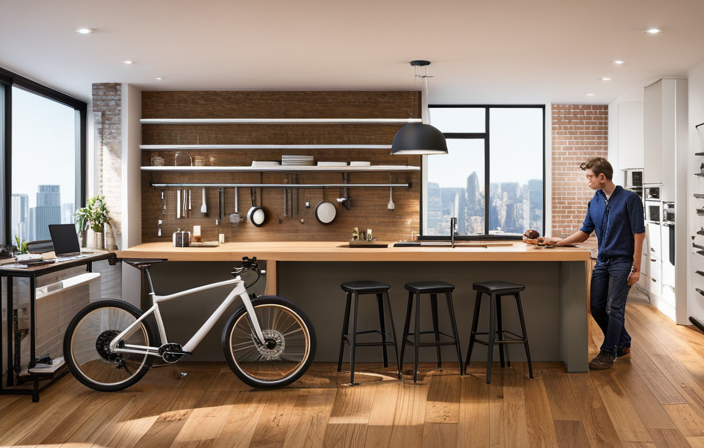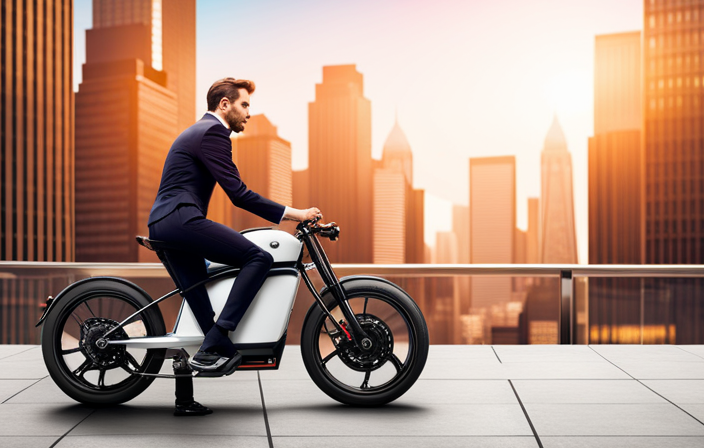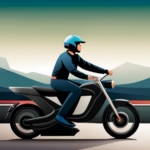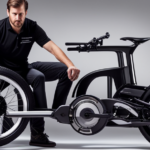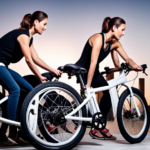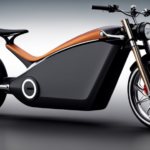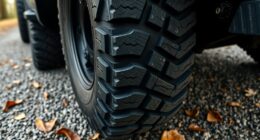I’m thrilled to share the story of how I built my own electric bike. It’s been an exciting journey of research, trial and error, and ultimately, success.
In this article, I’ll guide you through the process of selecting the right components, from the frame to the motor and battery. We’ll also discuss power management, maintenance, and the many benefits of electric biking.
Get ready to discover the freedom and sustainability that comes with building your own electric bike.
Key Takeaways
- Importance of finding the right components
- Factors to consider when selecting components (frame, motor, battery, controller)
- Customizing your electric bike with accessories
- Regular maintenance to ensure optimal performance
Researching Electric Bike Components
I’m currently researching the best electric bike components for my project. When it comes to building an electric bike, finding the right components is crucial for a successful outcome.
I have been diving deep into the world of electric bike components, comparing prices and brands to ensure I make the most informed decisions. From motors and batteries to controllers and displays, each component plays a vital role in the overall performance and functionality of the bike.
Finding the Right Frame for Your Electric Bike
Finding the right frame for your e-bike can greatly impact its performance. When choosing the frame material, it’s important to consider factors like weight and size. Here are four key considerations to keep in mind:
-
Frame Material: Look for materials that strike a balance between strength and weight. Aluminum is a popular choice due to its lightweight nature and durability. Carbon fiber frames offer excellent strength-to-weight ratio but tend to be pricier.
-
Weight: A lighter frame can enhance maneuverability and make uphill rides easier. However, keep in mind that lighter frames may sacrifice some durability.
-
Size: Ensure that the frame size is suitable for your height and riding style. A well-fitted frame provides better control and comfort during rides.
-
Frame Design: Consider the frame’s design, such as the geometry and suspension options. These factors can affect the bike’s handling and performance in different terrains.
By carefully considering the right frame material, weight, size, and design, you can optimize your e-bike’s performance.
Now, let’s delve into choosing the perfect motor for your electric bike.
Choosing the Perfect Motor for Your Electric Bike
When choosing the perfect motor for your e-bike, consider factors such as power output and torque to match your riding needs. Motor power requirements vary depending on the type of riding you plan to do. For example, if you’re looking for a motor that can handle steep hills and rough terrains, you’ll need one with higher power output. On the other hand, if you’ll be mostly riding on flat surfaces, a motor with lower power output would suffice. Additionally, motor efficiency ratings should also be taken into account. A more efficient motor will provide better performance and longer battery life. Here’s a table showcasing some popular e-bike motors and their specifications:
| Motor Brand | Power Output (Watts) | Torque (Nm) |
|---|---|---|
| Bafang | 750 | 80 |
| Bosch | 500 | 75 |
| Shimano | 250 | 50 |
| Brose | 350 | 60 |
| Yamaha | 500 | 70 |
Now that we have covered the motor power requirements and efficiency ratings, let’s move on to selecting the right battery for your electric bike.
Selecting the Right Battery for Your Electric Bike
Once you’ve chosen the perfect motor, it’s important to select the right battery for your e-bike. The battery capacity you choose will greatly impact the overall performance and range of your electric bike. When comparing battery types, consider the following factors to make an informed decision:
- Lithium-ion: Lightweight and long-lasting, these batteries offer high energy density for extended rides.
- Lead-acid: Affordable and reliable, but heavy and less efficient compared to other options.
- Nickel-metal hydride (NiMH): A middle-ground choice, offering a balance between affordability and performance.
- Lithium polymer: Similar to lithium-ion batteries, these are flexible and can be shaped to fit specific bike designs.
- Nickel-cadmium (NiCd): Durable and reliable, but less common due to the environmental concerns associated with cadmium.
By carefully considering these options and choosing the battery capacity that suits your needs, you can ensure optimal performance for your e-bike.
Now, let’s move on to the next crucial step: adding a controller for power management.
Adding a Controller for Power Management
To optimize the performance of your e-bike, you’ll need to add a controller that manages the power efficiently. The controller plays a crucial role in power optimization and energy efficiency. It regulates the flow of electricity from the battery to the motor, ensuring that the right amount of power is delivered at all times.
By effectively managing the power, the controller helps to extend the battery life and maximize the distance you can travel on a single charge. Additionally, it allows you to customize the power delivery to suit your riding style and preferences. With a high-quality controller, you can achieve a smooth and responsive ride while conserving energy.
Now, let’s move on to installing the pedal assist system, which further enhances the performance and efficiency of your e-bike.
Installing the Pedal Assist System
Don’t forget to install the pedal assist system, as it greatly enhances the performance and efficiency of your e-bike. This system provides a boost to your pedaling power, making it easier to ride uphill or for longer distances.
To install the pedal assist system on your e-bike, follow these steps:
- First, locate the pedal assist sensor on the bottom bracket of your bike.
- Remove the crank arm using a crank puller tool.
- Attach the pedal assist sensor to the bottom bracket, making sure it is securely fastened.
- Reinstall the crank arm and tighten it properly.
- Connect the sensor wires to the controller, ensuring a solid connection.
- Mount the controller securely on your e-bike frame.
- Finally, connect the battery to the controller and test the pedal assist system.
Troubleshooting common issues with the pedal assist system:
- If the pedal assist is not working, check the connections between the sensor, controller, and battery.
- Ensure that the sensor is properly aligned with the magnet on the pedal crank.
- If the system still doesn’t work, consult the manufacturer’s manual or seek professional assistance.
By installing the pedal assist system, you’ll be able to experience a smoother and more enjoyable ride on your e-bike.
Now, let’s move on to customizing your electric bike with accessories.
Customizing Your Electric Bike with Accessories
Now, let’s explore how you can personalize your e-bike by adding accessories.
Customizing handlebars is a great way to enhance your riding experience. There are various options available, including adjustable handlebars for optimum comfort and control.
Additionally, choosing the right accessories can greatly improve your e-bike’s functionality and style. For instance, a phone mount can help you navigate while riding, and a water bottle holder ensures hydration on long trips. Rear racks provide extra storage space, and fenders protect you from mud and debris. Don’t forget about safety accessories like lights and bells. These choices are essential to tailor your electric bike to your specific needs and preferences.
Now that you have personalized your e-bike, let’s move on to wiring and connecting the components seamlessly.
Wiring and Connecting the Components
Make sure you connect the components securely to ensure proper functionality and a smooth riding experience.
When it comes to wiring techniques for your electric bike, there are a few key things to keep in mind.
First, always use the appropriate gauge of wire for each component, as using the wrong size can lead to overheating and potential damage.
It’s also important to use proper connectors and terminals to ensure a secure and reliable connection.
When troubleshooting your wiring, start by checking for loose connections or frayed wires. Look for any signs of damage or corrosion and replace any faulty components promptly.
By following these wiring techniques and troubleshooting tips, you can ensure that your electric bike is wired correctly and functions optimally.
As we move into the next section, testing and troubleshooting your electric bike, we will explore how to identify and resolve any issues that may arise during operation.
Testing and Troubleshooting Your Electric Bike
To ensure proper functionality, it’s important to test and troubleshoot your electric bike for any potential issues that may arise during operation. Here are some key steps to follow:
-
Troubleshooting battery issues:
-
Check the battery connections to ensure they are secure and free from corrosion.
-
Test the voltage output of the battery using a multimeter to ensure it is within the manufacturer’s specifications.
-
Testing motor power output:
-
Connect the motor to a power source and measure the current draw using a clamp meter.
-
Use a tachometer to measure the motor’s RPM and compare it to the manufacturer’s specifications.
By thoroughly testing and troubleshooting these components, you can identify any potential issues and address them before they become bigger problems. This will help ensure the smooth and efficient operation of your electric bike.
Moving forward, let’s explore making modifications for performance enhancement.
Making Modifications for Performance Enhancement
If you want to improve the performance of your electric bike, there are several modifications you can consider. Performance upgrades can help optimize power usage and enhance the overall riding experience.
One way to achieve this is by upgrading the battery capacity or voltage. A higher capacity or voltage battery can provide more power and increase the range of your electric bike.
Additionally, upgrading the motor can greatly improve performance. A more powerful motor can provide higher speeds and better acceleration.
Another modification to consider is changing the gearing system. By choosing the appropriate gear ratios, you can maximize power transfer and efficiency.
Lastly, upgrading the controller can enhance power management and improve overall performance. By optimizing power usage through these modifications, you can enjoy a more powerful and efficient electric bike.
To ensure safety and compliance with local regulations, it is important to thoroughly understand and follow the guidelines set by your local authorities.
Ensuring Safety and Compliance with Local Regulations
Ensure your safety and comply with local regulations by familiarizing yourself with the guidelines set by your local authorities. Understanding the legal requirements and ensuring safety standards are met are crucial when it comes to owning and operating an electric bike.
In many areas, electric bikes are subject to specific regulations, such as speed limits, age restrictions, and helmet requirements. It is important to research and understand these regulations to avoid fines or legal issues. Additionally, it is essential to ensure that your electric bike meets safety standards, such as having functional brakes, lights, and reflectors.
Regular maintenance and inspections are necessary to keep your electric bike in optimal condition and ensure your safety on the road. By following these guidelines and regulations, you can enjoy the benefits of your electric bike while minimizing any potential risks.
Transitioning into the next section about maintaining and caring for your electric bike, it is important to establish a routine maintenance schedule to keep your bike running smoothly.
Maintaining and Caring for Your Electric Bike
Regular maintenance is key to keeping your e-bike in good condition. Here are three important maintenance tips to help you avoid common troubleshooting issues:
-
Keep your battery charged: Regularly charge your e-bike battery to ensure optimal performance and extend its lifespan. A fully charged battery will give you maximum range and power.
-
Inspect and clean your bike regularly: Regularly check your e-bike for any signs of wear and tear, such as loose bolts or damaged cables. Clean your bike after each ride to remove dirt and debris, which can cause corrosion and affect performance.
-
Check tire pressure and brakes: Proper tire pressure ensures a smooth and efficient ride, while well-adjusted brakes ensure your safety. Regularly check the tire pressure and the condition of your brake pads to maintain optimal performance.
By following these maintenance tips, you can ensure your e-bike stays in top shape and avoids common troubleshooting issues.
Now, let’s move on to enjoying the benefits of your DIY electric bike.
Enjoying the Benefits of Your DIY Electric Bike
Now that you’ve built your DIY e-bike, it’s time to start enjoying all the benefits it has to offer. Electric biking is gaining popularity due to its numerous advantages. Let’s take a look at some of the benefits of electric biking in the table below:
| Benefits of Electric Biking | Increasing Popularity of Electric Bikes | Improved Fitness |
|---|---|---|
| Eco-friendly | Reduce carbon footprint | Increased stamina |
| Cost-effective | Save money on transportation | Enhanced endurance |
| Convenient | Avoid traffic congestion | Improved cardiovascular health |
| Fun and enjoyable | Explore new places effortlessly | Enhanced mental well-being |
As you can see, electric biking offers environmental benefits, cost savings, convenience, and a fun way to explore. It also provides health benefits such as improved fitness, stamina, and cardiovascular health. Now that you are aware of these advantages, let’s move on to sharing your electric bike building experience with others, so they too can enjoy the benefits of electric biking.
Sharing Your Electric Bike Building Experience with Others
Share your experience of building your DIY e-bike with others so they can also enjoy the benefits of creating their own electric transportation. When it comes to sharing experiences, there’s nothing quite like the satisfaction of seeing someone else successfully build their own electric bike based on your guidance.
It’s not just about the end result, but also the troubleshooting tips you can provide along the way. From choosing the right components to wiring and assembly, sharing your knowledge can help others overcome challenges and build their dream e-bike.
Embracing the Freedom and Sustainability of Electric Biking
You can experience the freedom and sustainability of riding an electric bicycle by embracing the eco-friendly benefits it offers.
Electric biking provides a unique and efficient mode of transportation that is both fun and environmentally friendly.
One of the key benefits of electric biking is the freedom to travel long distances without worrying about exhaustion or fatigue. The electric motor assists you as you pedal, making it easier to conquer hills and cover more ground. This means you can explore new places and enjoy the outdoors without the limitations of traditional biking.
Additionally, electric biking is a sustainable choice that helps reduce carbon emissions and air pollution. By opting for an electric bike, you contribute to a greener and cleaner environment.
Frequently Asked Questions
How can I ensure that my DIY electric bike complies with local regulations?
To ensure compliance with local regulations and legal requirements, I would thoroughly research the specific laws and regulations for electric bikes in my area. This would include checking speed limits, licensing requirements, and safety equipment specifications.
What are some common troubleshooting issues that may arise when building an electric bike?
Common issues when building an electric bike include battery connectivity problems, motor malfunctions, and controller issues. Troubleshooting techniques involve checking wiring connections, testing voltage levels, and inspecting components for damage.
Are there any specific safety measures I should take when assembling the components of my electric bike?
When assembling the components of an electric bike, it is crucial to prioritize safety precautions. I always wear protective gear like gloves and goggles, and double-check all connections to ensure proper assembly.
How can I enhance the performance of my electric bike through modifications?
To enhance the performance of your electric bike, there are several top modifications you can make. Upgrading the battery and motor, installing a more efficient controller, and improving the aerodynamics are all key ways to maximize your electric bike’s performance.
What are the benefits of building and owning a DIY electric bike compared to purchasing a pre-made one?
Building and owning a DIY electric bike offers numerous benefits compared to purchasing a pre-made one. With customization options, I can tailor the bike to my specific needs, and the cost savings are significant as I can source and assemble the components myself.
Conclusion
In conclusion, building my own electric bike has been an incredibly rewarding journey.
I’ve delved into the world of electric bike components, carefully selecting the perfect frame, motor, battery, and controller.
The process of maintaining and caring for my electric bike has been a breeze, and the benefits of this DIY project have been truly remarkable.
Not only do I now enjoy the freedom and sustainability of electric biking, but I also have the opportunity to share my building experience with others.
It’s an exhilarating feeling, knowing that I’ve created something truly special.
